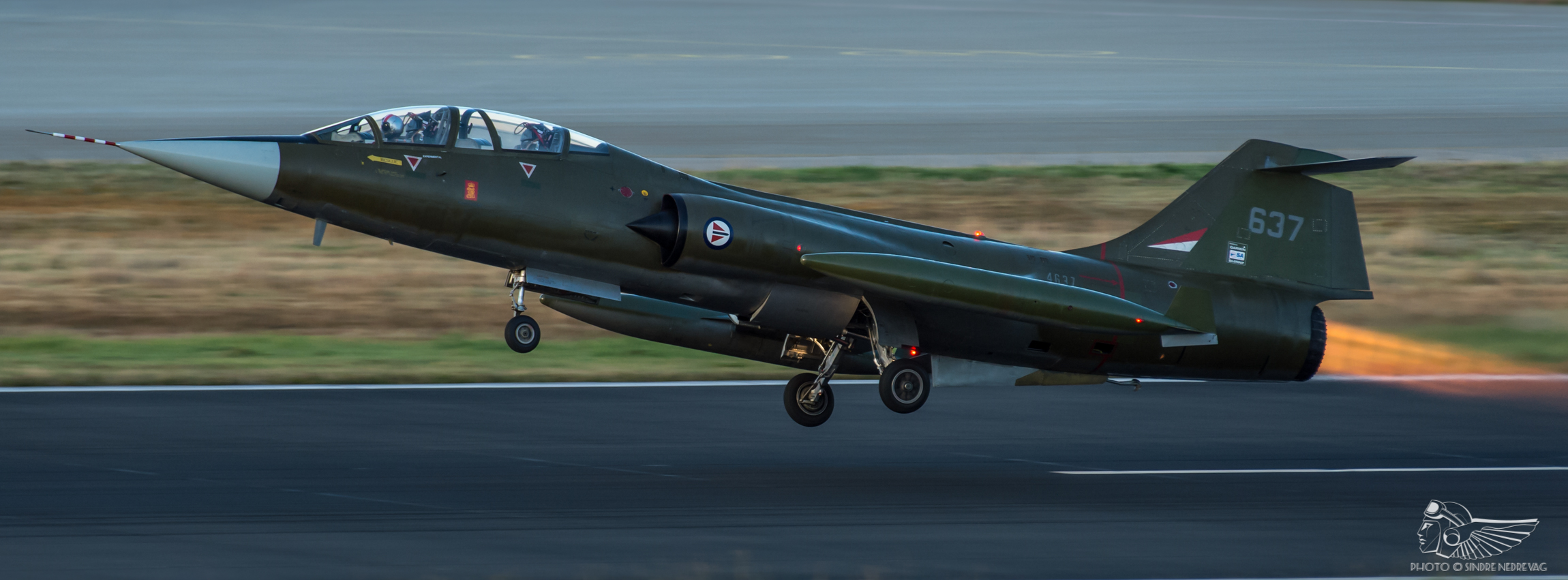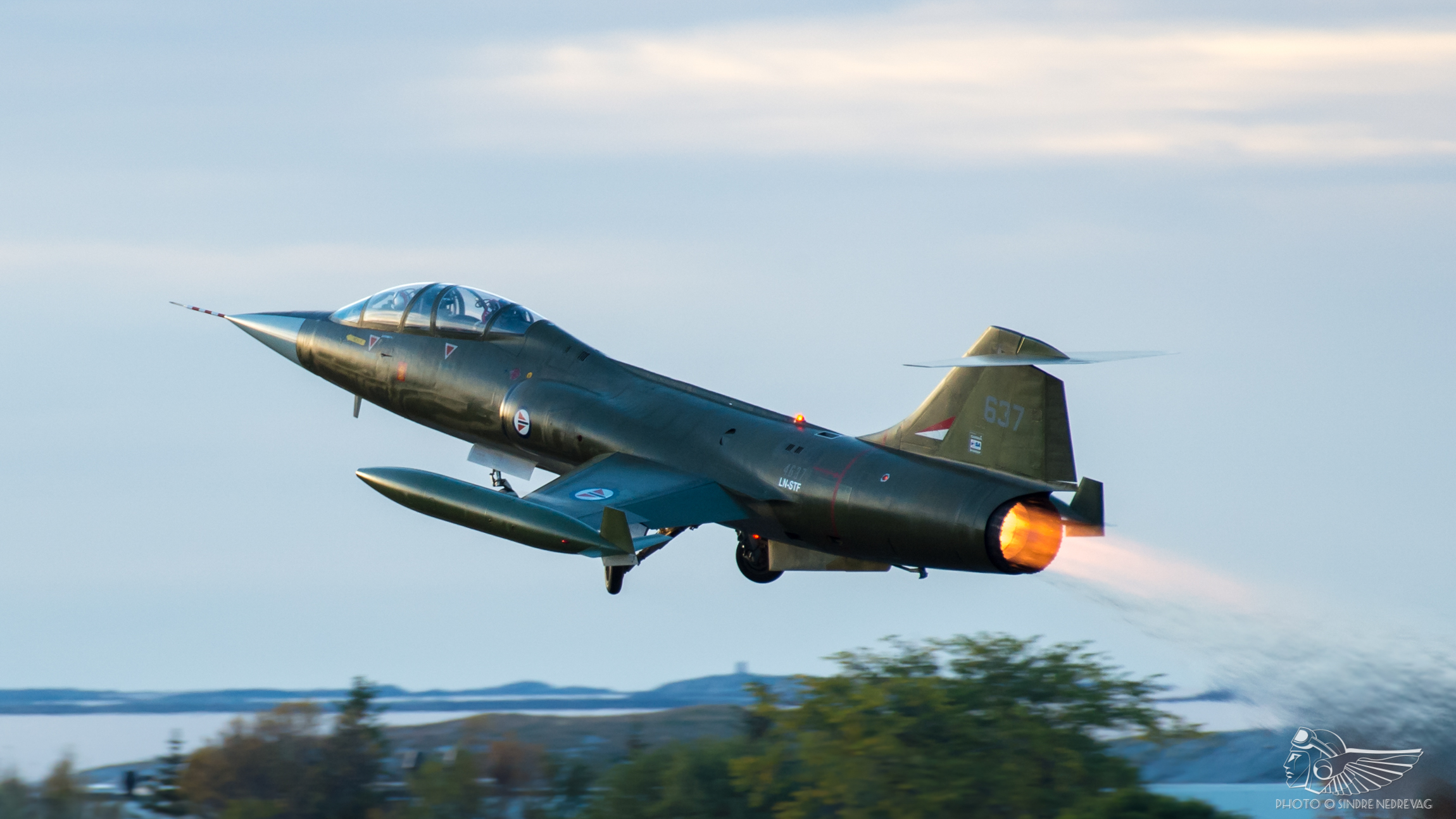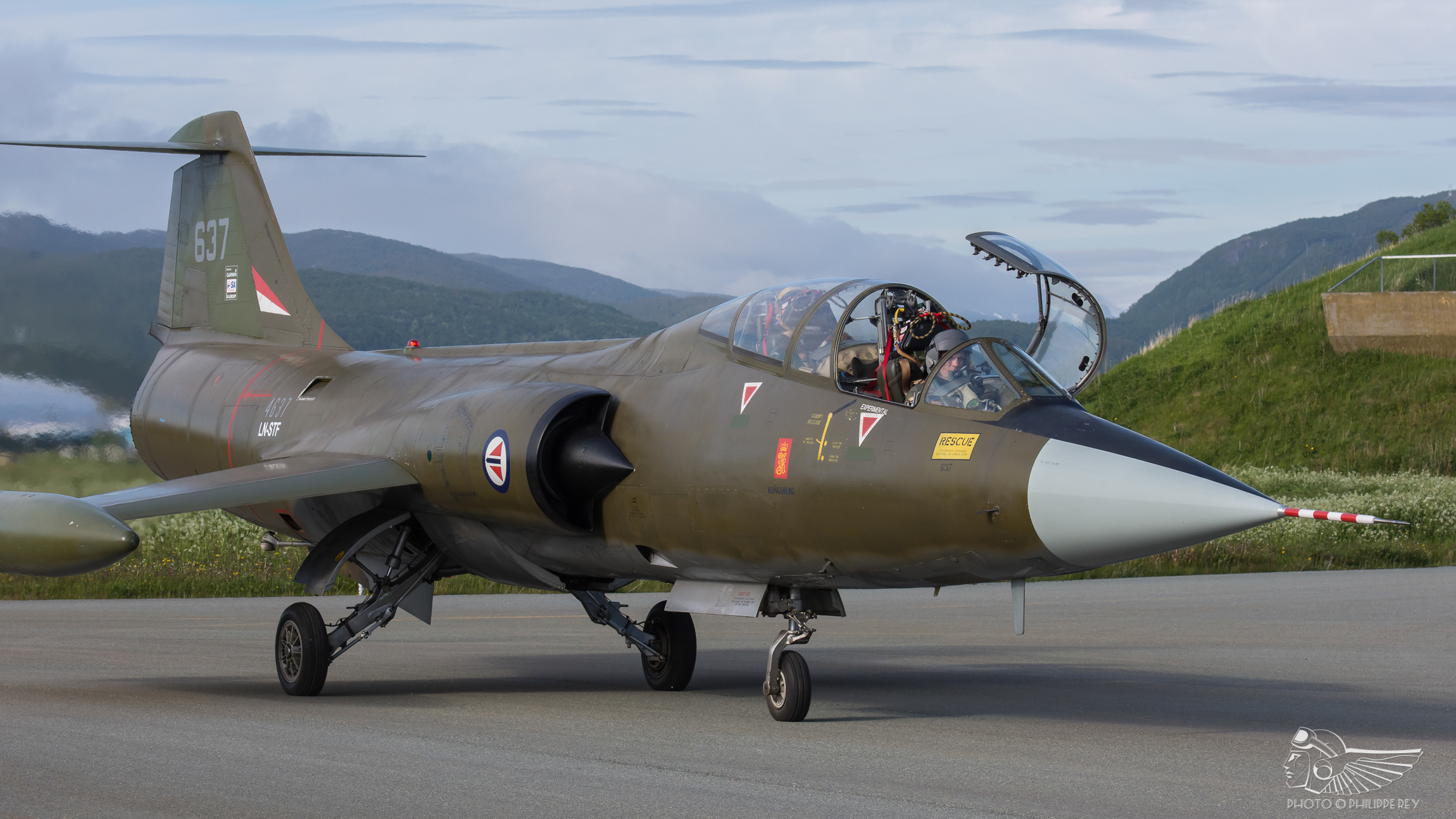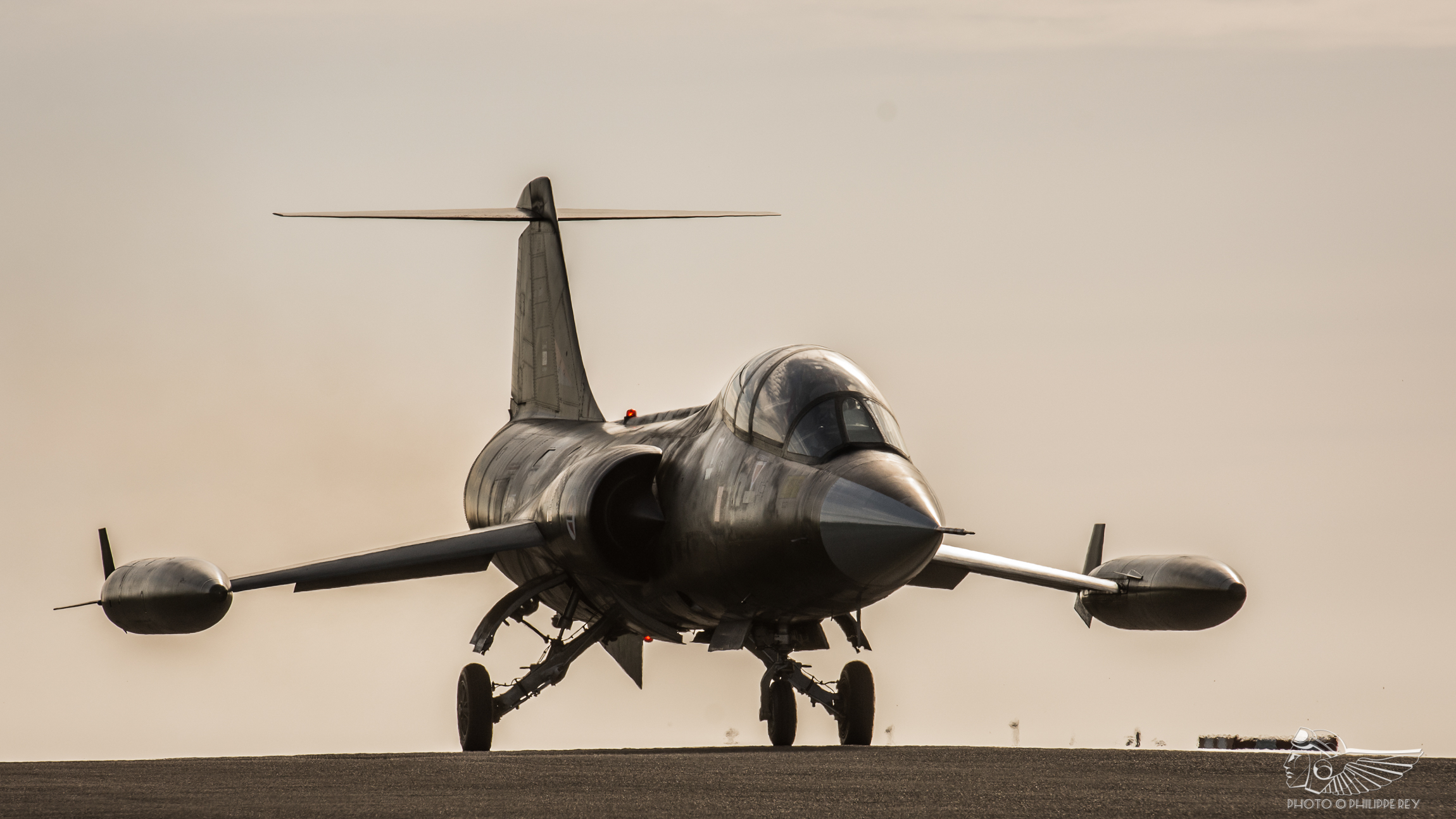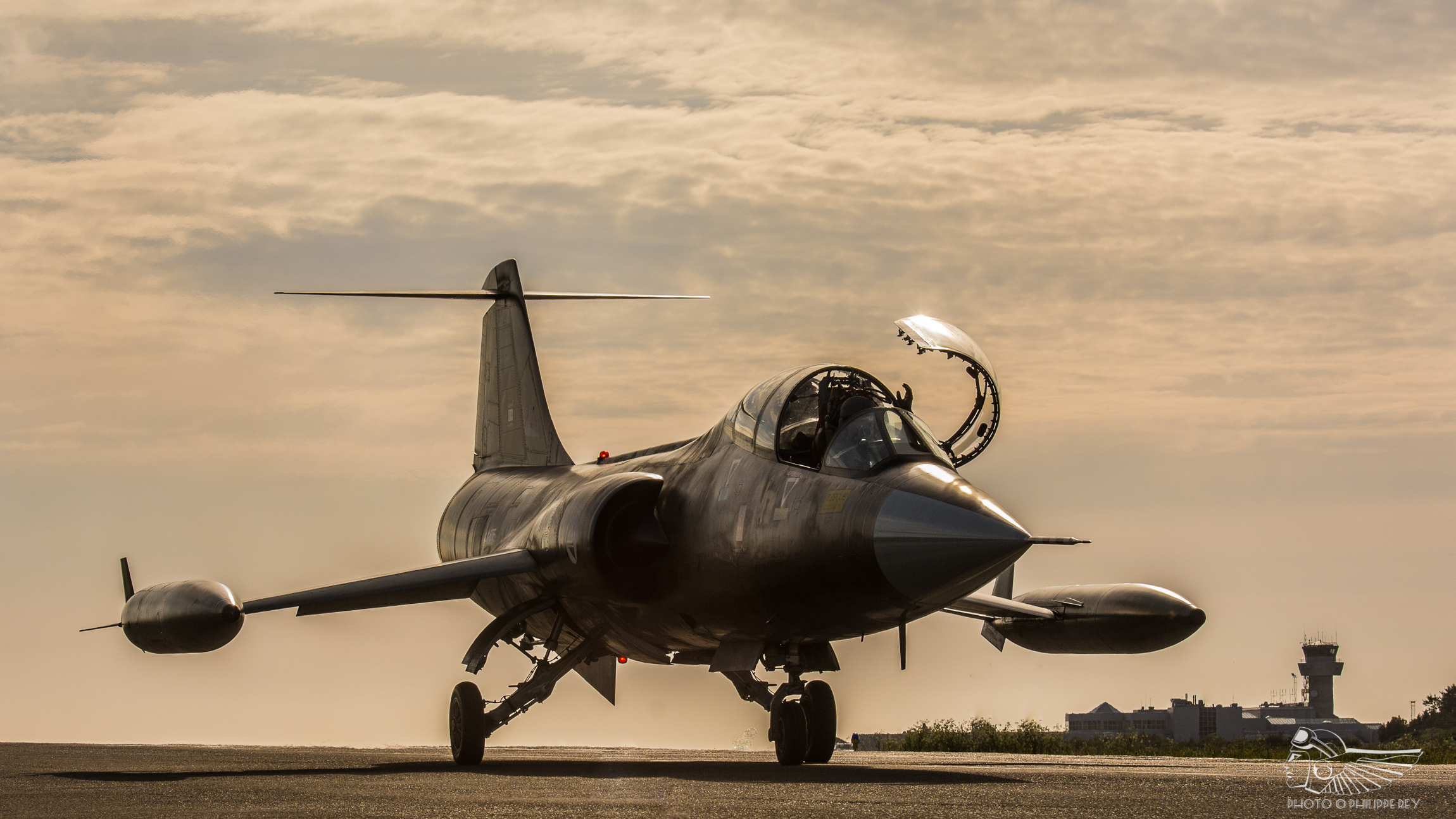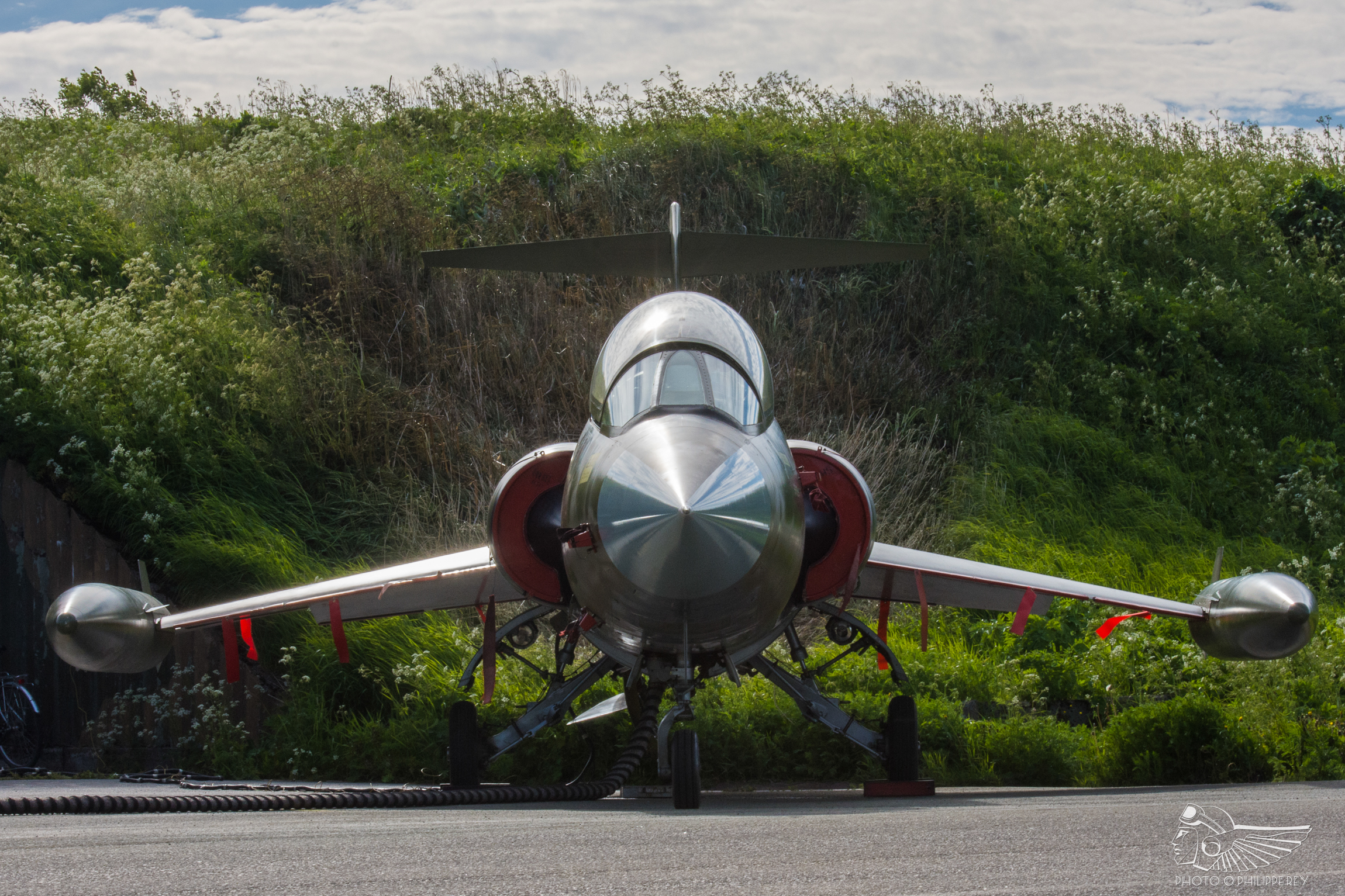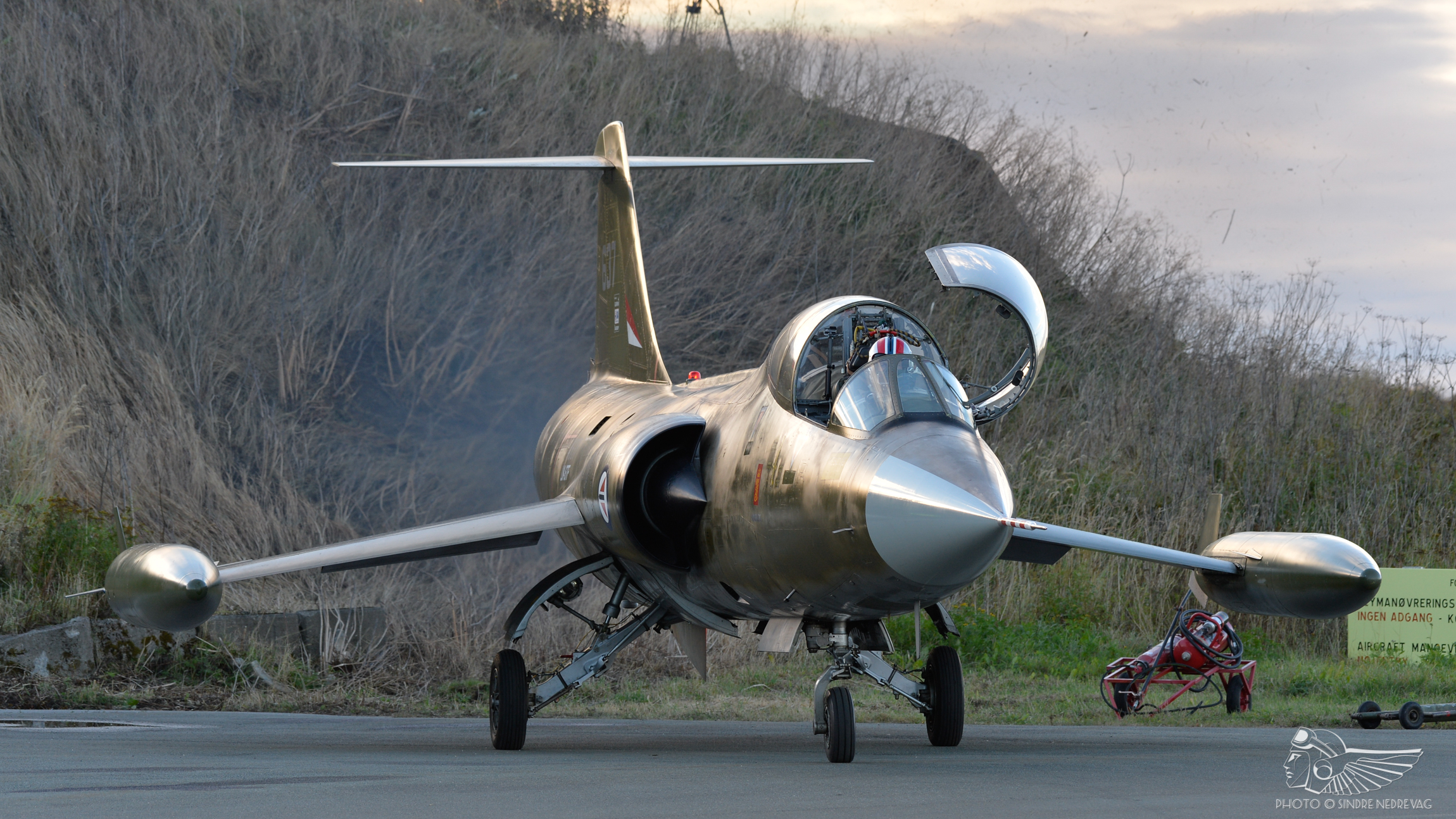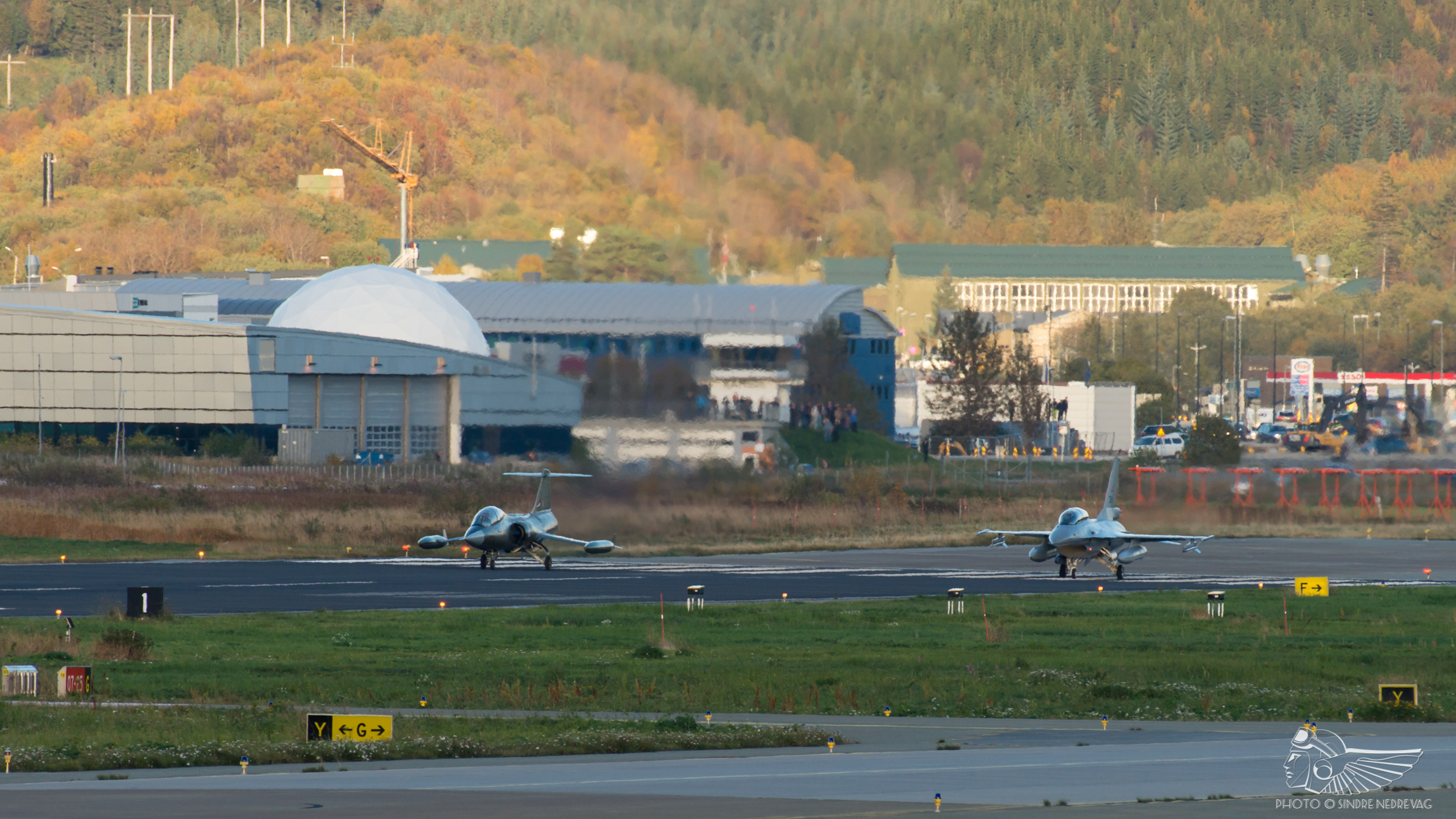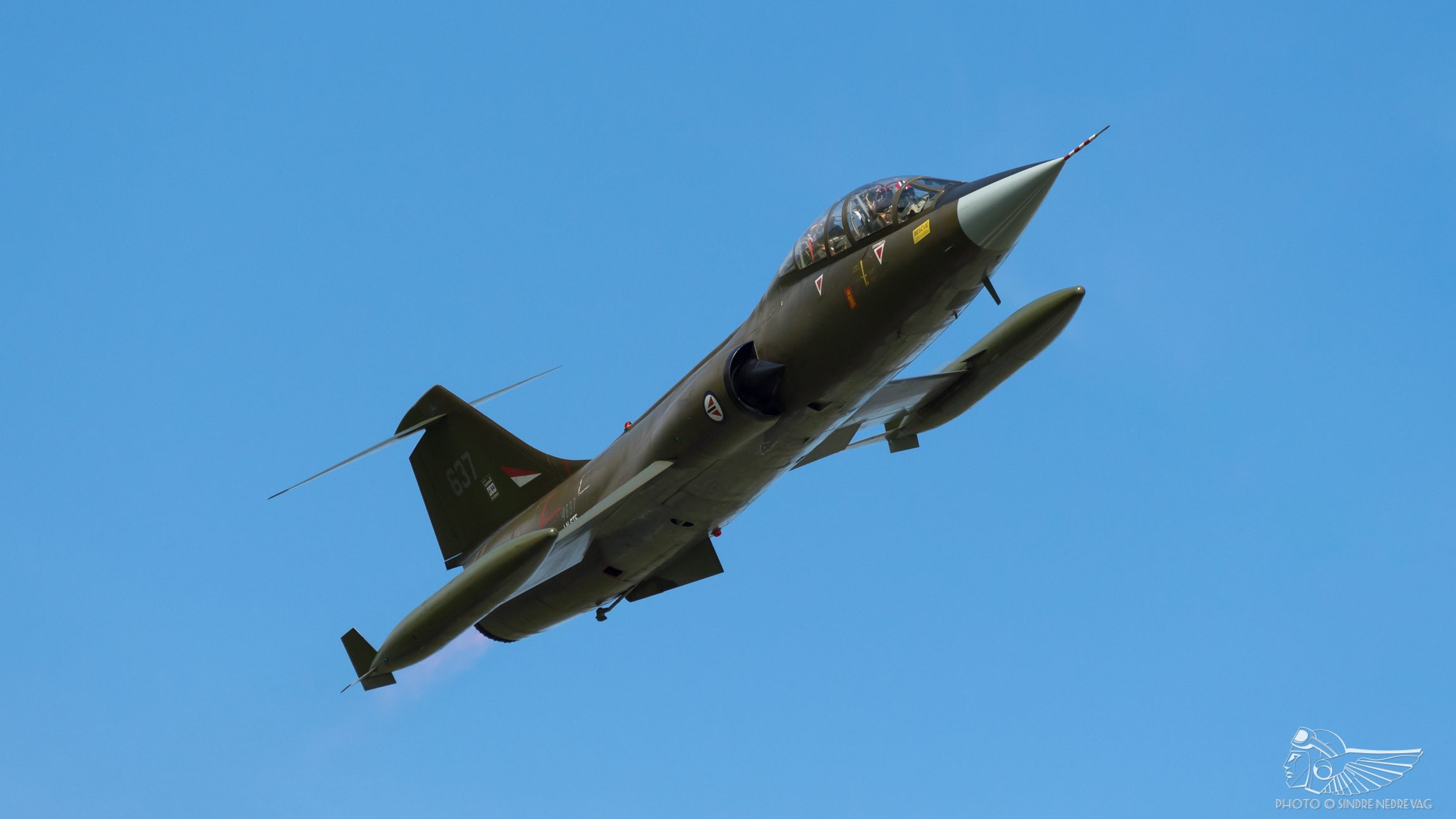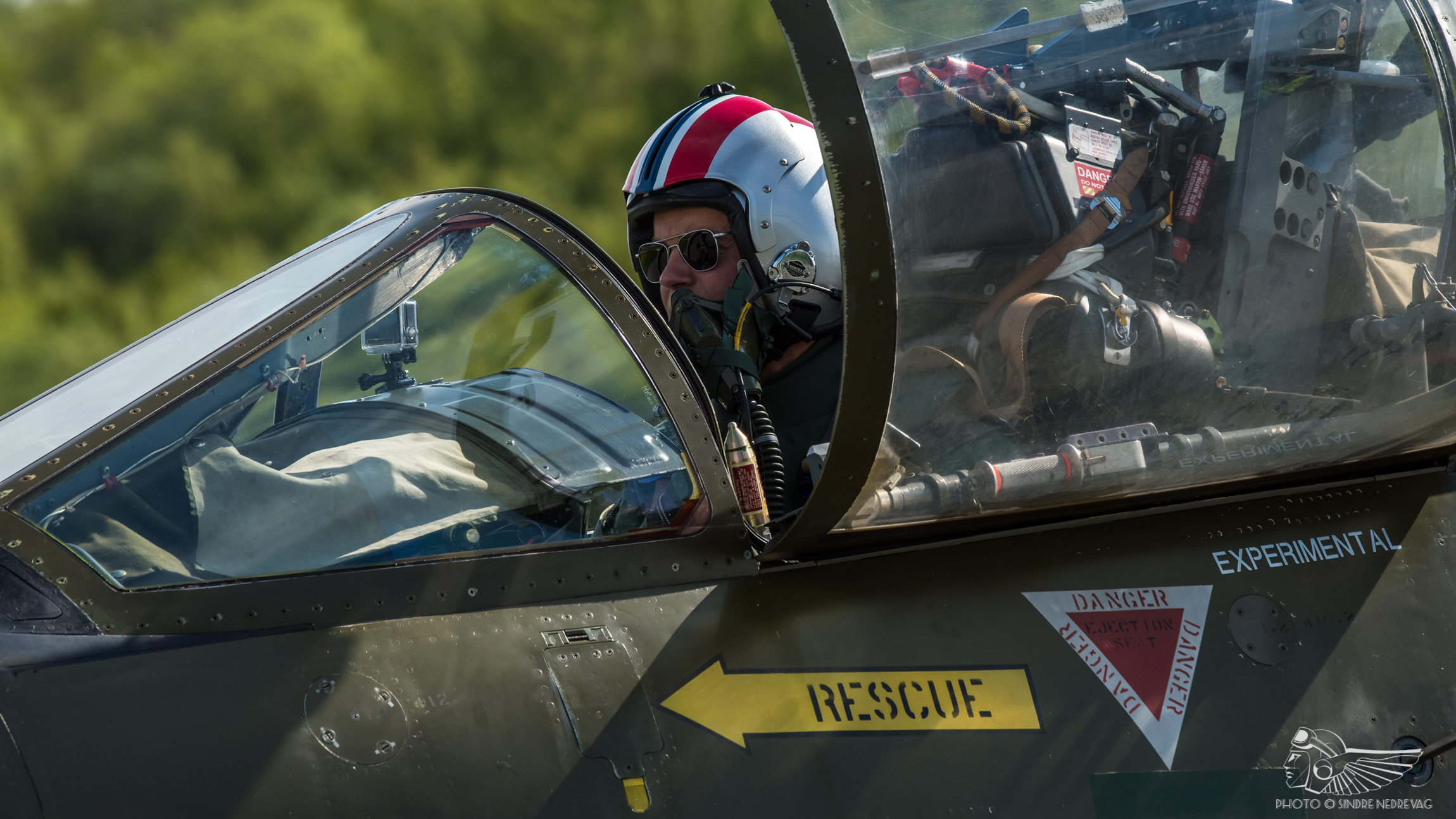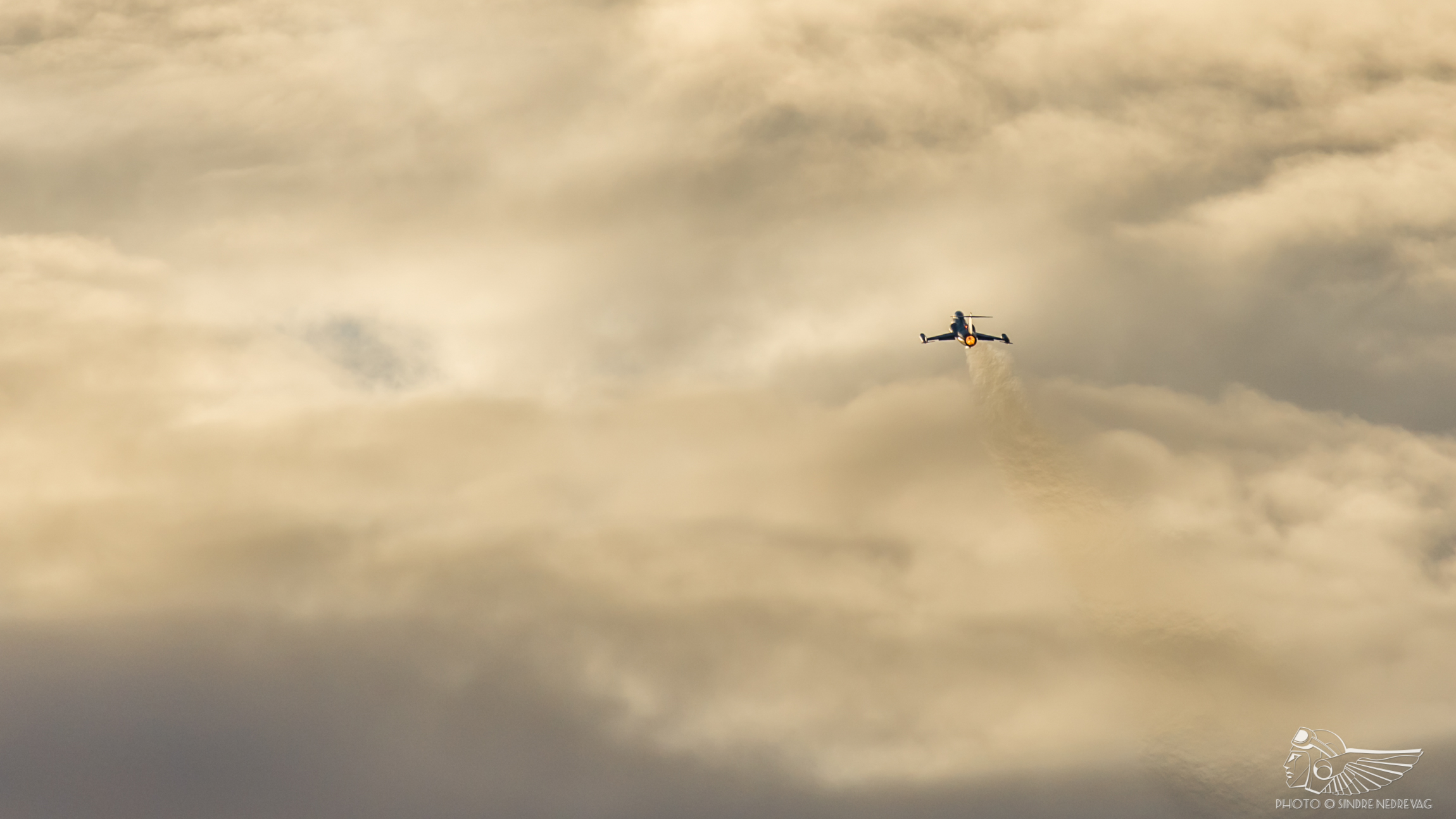The 13-year restoration of CF-104D Starfighter “637” (LN-STF) concluded on 28 September 2016 as fighter pilot Eskil Amdal got airborne from Bodø, Norway for a 40-minute test flight. It was the first Starfighter to launch from the historic air base in over 33 years, signalling the return to European skies of one of the most revered century-series fast-jets.
The Starfighter is a CF-104D that served with the Canadian Armed Forces from May 1962. A stint with a test unit at Cold Lake, Alberta followed and the aircraft passed to the Royal Norwegian Air Force in May 1973, arriving in Norway on 14 June 1973 and receiving the serial number “637”. The Starfighter joined 334Skv at Bodø Air Base, flying operationally until 1 April 1983; following retirement, the CF-104 remained at Bodø, Norway’s second largest city just north of the Arctic Circle.
The Norwegian Foreningen Starfighterens Venner (Friends of the Norwegian Starfighter Association) formed at Bodø in January 2003 and acquired CF-104D “637”, placing it under the care of 334Skv with the intention of returning the jet to flight. A protracted restoration followed, though progress was slow; it was September 2007 before the engine ran for the first time since overhaul, and taxi trials were undertaken the following summer. With the assistance of the Norwegian Civil Aviation Authority (CAA) the Starfighter was placed on the civil register as LN-STF in November 2011.
Eskil Amdal, early-40s, has a wealth of fast-jet experience, piloting the F-16 Fighting Falcon for the Royal Norwegian Air Force (RoNAF), graduating from the US Naval Test Pilot School in 2008, displaying the RoNAF F-16 demo at airshows in 2012 and spearheading F-35 Lightning II development as an experimental test pilot in the USA. In recent years he has flown both Spitfire Mk.IX and P-51D Mustang and is a certified warbird Flight Instructor at the Boultbee Flight Academy. Test pilot expertise, military disciplines and a profile within the historic aviation scene made him uniquely skilled to take on the challenges of the CF-104’s flight testing.
“The Starfighter was the Cold War icon when I was a child”, reflects Eskil. He was 10 when the F-104 retired from RoNAF service in 1983, but the aircraft’s reputation long superseded its service career. “The love for the F-104 was something the older pilots always talked about with real affection. Italy flew the jet until 2004 and there are still Italian Air Force pilots who talk about the love of their life. Anyone who flew it gravitates towards it straight away.” Eskil has been involved in the Starfighter project since 2011, at which point the aircraft’s first flight was anticipated within the year. Myriad factors conspired against that time frame, not least the extensive paperwork exercise required to satisfy the Norwegian CAA that an afterburning classic jet could be safely operated in civilian hands.
The five-year lead-in to the Starfighter’s return gave Eskil ample time in which to prepare himself for handling the F-104. ‘Kelly’ Johnson’s design was the by-product of a generation reaching inexorably for the stars; the Starfighter was built for speed, its extremely thin flight surfaces and short, straight wings tailored to its original role as a high-performance, all-weather, day and night interceptor designed for high subsonic cruise and high supersonic combat speeds. A close-combat dogfighter this was not, and the Starfighter’s flight dynamics offered their own unique challenges with which Eskil would familiarise himself before getting airborne.
The irreversible-hydraulically-powered flight controls mean that stick forces remain constant at all speeds – thus the pilot feels the same pressure when moving the stick on the ground as he will do at Mach 1 and above. In-flight, an Automatic Pitch Control (APC) system introduces anticipatory stick shake and a manual pitch override – the ‘shaker’ and the ‘kicker’ – to prevent the pilot from pitching too hard and exceeding the angle of attack (AOA) limitations imposed by the aircraft’s low aspect ratio wings and ‘T-tail’ empennage. In the landing pattern, increase in lift is achieved using a boundary layer control system which blows bleed air from the engine back over the trailing edge flaps when they are extended to the landing position. It’s a fighter with many traits unfamiliar to the modern jet pilot and earned its infamous reputation during a service career fraught with incident; in Germany, where more than 100 air force and navy pilots were killed flying F-104s, it received a triple header of unflattering nicknames – Fliegender Sarg (‘Flying Coffin’), Witwenmacher (‘Widowmaker’) and Erdnagel (‘Ground nail’).
Keeping what he describes as “a number of potential dangers” in mind, Eskil’s preparatory research included extensive discussions with former Starfighter crews, both engineers and pilots, and hundreds of hours were spent trawling through materials including operations manuals, US Air Force and Lockheed flight test reports, pilots’ accounts and flight data although, as he explains, there is a fine line between listening to experiences and drawing an accurate picture of Starfighter operation. “A lot of pilots look at it like an old girlfriend; they remember the good things and have forgotten the bad – a lot of contradictions.” Knowledge was consolidated into the CF-104’s checklists, pilot’s notes and Operational Control Manual, which Eskil drew up in the intervening years. “I wasn’t just going to show up to be the pilot. I became a fully-fledged member of the team during that time.”
He spent many hours in the hangar at Bodø familiarising himself with the aircraft’s cockpit layout. Putting aside a modern Garmin GPM-750 radio, it is largely stock and Eskil describes the environment as being very manual as compared to later fast-jets, with a raft of systems; the Starfighter was developed in an era before automation was standard for western jets and there is a lot to occupy the pilot. However, with the weapons systems and radar removed, the bulk of the cockpit in “637” is focused on the aircraft’s operating systems. “It’s designed around the pilot”, he says. “It’s a classic cockpit from that era, very self-explanatory. Engine instrumentation dominates at the expense of other systems. The hydraulic systems gauges are not even an inch in diameter and are hidden way down, you really have to look if you want to read them properly.” As the flight drew near, Eskil spent more time in the aircraft and began running through cockpit procedures blindfolded, even doing so in front of the project’s chairman on occasion.
After thousands of hours of restoration and dedication from its test pilot and engineers, CF-104D Starfighter “637” was ready to take to the skies again on 28 September 2016. A far cry from the preferred discrete morning sortie, the Starfighter’s test flight was scheduled for a Wednesday afternoon and heavily publicised across social media. The Friends of the Norwegian Starfighter Association broadcast live on their Facebook page for hours before Eskil even strapped in, and Norwegian national television arrived to ensure that the occasion aired across the country – the first post-restoration flight of this complex classic jet, untested in private hands outside the USA, would be streamed live to thousands. Quite literally, the eyes of the aviation world were watching.
Eskil would be taking the Starfighter away from Bodø and into the controlled airspace of a military training area, where flight testing would be performed at an altitude up to 20,000ft. A RNoAF F-16B Fighting Falcon was tasked as a chase aircraft and would be on hand to carry out visual inspection. This would be a 40-minute sortie based on a standard military test regime, concluding with two low approaches (the CAA having vetoed touch-and-goes that would place the aircraft nearer the city of Bodø on the climb out) prior to landing.
Engine start-up in the Starfighter is fairly simple; a ground turbine compressor is connected to the aircraft by the Crew Chief to produce an rpm of 10% before the engine starter switch is engaged. The throttle is advanced from Off to Idle, opening the fuel cut-off valve, and as jet pipe temperature (JPT) increases the low-pressure air for start-up is removed at 40% rpm. Stabilised at Idle power, the ground power is disconnected by the Crew Chief. Though Eskil and his Crew Chief have worked together in the RNoAF on F-16s, the CF-104 presents new challenges. Currency is fairly low on type and to mitigate against this a modern intercom has been installed to enable pilot and Crew Chief to communicate directly, rather than relying solely on hand signals as was standard during the Starfighter’s military years.
“Taxying takes a bit of getting used to”, he continues. Manoeuvring on the ground is achieved by pressing and holding down the nose wheel steering button until rudder effectiveness is achieved, unlike many jets which require single clicks to engage and disengage steering. “You sit in front of the nose wheel steering and you can’t see the wings, so it feels like you’re sitting on the handlebars of a motorbike. There were a couple of tight corners where I thought I was going to run off the edge of the taxiway but the Crew Chief called me through. It feels like a rocket, even on the ground.”
Positioning the aircraft on the runway centreline, Eskil carried out final pre-flight checks before making the decision to go. JPT, fuel flow, oil pressure, rpm and nozzle position all looked good. This was it – the return to flight of a genuine aviation legend, 33 years in the making. He describes the take-off procedure: “Hold the aircraft on the brakes and advance the throttle through Military Thrust to 100% rpm. After a quick engine check, release the brakes and light the mid-burner first, followed by full afterburner. The burner hesitates for a fraction of a second, then it lights fully and God, it really kicks in!”
The aircraft rotates at 170kts in no time at all and is airborne at 190 at an 8-10° pitch attitude. “The decision point to abort take-off is raising the gear”, Eskil notes, “and if you try to lower the gear midway through a cycle, it is likely to jam. Raising the gear is the decision to go!” As the Starfighter lifted from Bodø’s runway, Eskil felt the wing drop immediately to the right, requiring instinctive left-roll to arrest it. “I didn’t know how much stick input was needed to level the aircraft, and I overcompensated slightly – you can see a slight waggle on the video feed”, he says. “But you learn. The feedback from the aircraft to brain to stick happens within a split second and you learn how the aircraft handles within such a short time span.”
As the CF-104 climbed away from Bodø at 5.25pm with full afterburner, the airborne chase carried out a 360 degree turn and formated on the Starfighter. “I was climbing like a homesick angel and the F-16 was flat out at full afterburner struggling to catch up!” Only when the Starfighter dropped back into Military Thrust was the Fighting Falcon able to close the gap; decades after retirement, the CF-104D still offers formidable performance. For Eskil, a “normal guy trying to fly an abnormal aeroplane”, the first moments of the flight were “a balance between adrenaline and doing what you need to do to assess the aeroplane and keep it safe. Controlling emotions versus being a professional test pilot!”
Closing the throttle to just below Military Thrust at around 400kts and 4,000ft, Eskil noted the red gear warning light showing in the gear handle, indicating the undercarriage was still down. “I looked at it and thought, I’m well over the gear limit speed of 240kts. I was sure the gear had retracted.” Later analysis revealed that an incorrect air data computer signal had triggered the warning, despite the gear being safely retracted. “That occupied me for a while – the chase came up and confirmed gear was fully up and I noted the red light went off when I increased the throttle to Military Thrust, but I kept that in the back of my mind for the rest of the flight.” A further concern arose in the climb as the cabin pressure increased with the altitude, indicating that the cockpit had not pressurised; with the oxygen regulator working well, Eskil ensured he was receiving 100% oxygen and continued on with the flight. Post-flight inspection determined that the cockpit’s hardened rubber seals, unused for three decades, were responsible for the pressurisation failure – a fault easily rectified ahead of future sorties.
Technical issues overcome, Eskil climbed to 15,000ft to cycle the gear and flaps and test the boundary layer control, which was functioning correctly with no asymmetric roll-off. Much of the focus during the test flight was on the General Electric J-79 engine, an ageing but reliable power plant which requires respectful handling, as Eskil recalls. “The F-16 has care-free handling where you can slam it from Idle to full afterburner and the computer will calculate the thrust it’ll give you. With the J-79 you need to monitor the nozzle, jet pipe temperature and rpm and understand what the engine is trying to do in terms of both thrust and stalls.” He explains that due to the huge pressure differences in front of and within the engine, the engine needs to be stabilised at Military Thrust for a couple of seconds before it can give afterburning power. Chop the throttle from afterburner to Military Thrust and back again, and the engine will likely suffer a compressor stall. Accordingly, throttle travel must be handled patiently to avoid this.
The afterburner is engaged by moving the throttle outboard and forward into the afterburner slot (around 95% rpm) and while start ignition is controlled by switches in front of the throttle, the afterburner is lit by a pilot flame that is confirmed operational by the Crew Chief before takeoff. A fuel flow divider and selector valve assembly distributes fuel to spray bar tubes in the tailpipe in four sequential stages – Primary Sector, Secondary Sector, Primary Uniform and Secondary Uniform. When the throttle is first advanced into the Primary Sector afterburner range, fuel is injected into the jetpipe from approximately 40% of the spray bars. Continue to open the throttle and an increase of thrust is felt as the Secondary Sector afterburner kicks in, igniting fuel injected from around 60% of the spray bars at the top and bottom of the jetpipe. At maximum afterburner, the Primary Uniform and Secondary Uniform ignition lights fuel from the full 360° spray bar ring, giving the greatest thrust increase.
As the throttle is opened, the increase in rpm rolls the aircraft to the right, not dissimilar to the gyroscopic effect on propeller-driven aeroplanes. “The engine wants to roll in an increased strength one way, and the airframe responds accordingly”, Eskil muses. “It’s just physics, one affects the other. In the F-16 and F-35, the flight control system initiates counteracting roll control so you don’t feel that. The F-104 is manual and rolls to the side with throttle increase – one of the things I’d read about, but experiencing it first-hand was really cool. It’s an old lady!”
From a handling perspective the CF-104D exhibits an impressive and crisp rate of roll, particularly at mid-range speeds where the removal of stick deflection will stop the aircraft instantly. This is because of the high roll-damping given by the lack of mass in the wings. A tendency for the nose to drop during the roll also requires concentration, particularly during low-level figures. In the high-subsonic range, aileron effectiveness deteriorates and roll capability is slightly impaired, though the stick forces remain the same at all speeds on account of the irreversible-hydraulically-powered flight controls; apply and maintain full stick deflection throughout successive rolls and the aircraft will likely overstress, causing roll-yaw-coupling and eventually disintegration.
During lateral manoeuvres the Starfighter requires at least Military Thrust to pull any kind of G, lest the speed wash off, and take-off flap must be deployed within the 450kt limit to provide sufficient lift in the turn. “In the early days of fighter training you’re taught that ‘speed is life’, and it absolutely applies here”, says Eskil. “It flies beautifully and fairly predictably for its design, but you have to maintain speed – you won’t be making any tight radius turns as it loses energy immediately when you apply back pressure to the stick.”
Overcook the AOA in a turn and the aforementioned ‘shaker’ introduces a significant precautionary “burble” in the stick. Continue the turn unabated and the APC system will automatically apply nose-down stabilisation and ‘kick’ the stick forward to avoid blanking airflow to the tail – “if you held it loosely it will literally push it out of your hands to break the angle of attack”. If ignored, the aircraft will develop a “massive sink rate” as it runs out of elevator and will enter an unrecoverable stall. The AOA limiter operates in tandem with a system which counteracts rapid angular pitch acceleration: “Pilots could scare themselves in ground attack”, cites Eskil, “as they might find themselves too low and pull the stick back hard. The rate-limiter would push the stick forward, which you really don’t want at lower altitude – hence some pilots manually disabled the system during low-level ground attack ops”.
Returning to base, the Starfighter enters the circuit at 325kts with take-off flap introduced prior to the overhead break. Unlike modern fighters which arrive with a vigorous roll-and-pull, Eskil explains that the Starfighter should be rolled to 60° of bank and flown gently to the downwind leg, the pilot ever mindful of the pitch and AOA limitations that are particularly prominent at lower airspeeds, before full landing flap is deployed. At this point asymmetric boundary layer control is a risk – feed bleed air to just one wing and the pilot would easily lose control of the aircraft, without the luxury of time or altitude to raise flap and correct the roll. Application of power would result in an increased differential in lift between the wings, making the roll more pronounced. Whilst the Crew Chief will always carry out a thorough pre-flight walk around to ensure bleed air is feeding through the ‘pin holes’ in each flap, an in-flight system failure cannot be discounted.
To mitigate against this, Starfighter operation changed over its career. After lowering the gear at 240kts, a combination of full-flap and throttle input at 1500ft (circuit altitude) gives the pilot recovery options in the event of asymmetric boundary layer control. Carrying out this brief test lasts mere seconds but could be life-saving, and was exercised by Eskil in the closing stages of his test flight. “I pushed the power up to counteract the massive drag that reduced speed to 200kts”, he explains, “and my hand was on the flap lever when I took it down to full-flap to check for roll-off before retracting to take-off flap. My hand went back to the throttle and I monitored spacing and airspeed. I didn’t know what my circuit spacing was supposed to be, but it turned out to be pretty spot on the first time – more luck than judgement!”
Throttle input was considerable as the aircraft rolled onto final, Eskil recording a speed drop-off to 180kts on approach as handling became a little sluggish. The approach, he recalls, is flown at 83% rpm – an unusually high power setting for a fast-jet, necessary to keep sufficient bleed air flow to the flaps. Drop the throttle to Idle in the approach configuration and the aircraft would stall with little altitude for recovery. Sinking over the keys, Eskil chopped the throttle to Idle and the main gear touched down at around 150kts; as the speed bled off, the air brake was deployed and the nose dropped, allowing nose-wheel engagement and deployment of the drag chute. Brake input isn’t necessary. “Then, massive relief! I thought it would be a lot harder to land”, Eskil muses, “but it was very gentle as long as you’re careful with the throttle and close it back to Idle and fly it down to the ground. On my second landing I brought the throttle back to Idle as I touched down, instead of flying it hard down to the ground before bringing it to Idle”.
As an interesting postscript to the sortie, Eskil noted later that his Garmin watch had recorded his heart rate throughout the test flight. Despite the early technical issues his pulse sat firm at 70-80 beats per minute, “except for the landing, where it hit 140! It’s a counter-intuitive way of flying an aeroplane with a real stigma, which triggered a very tense moment. It’s interesting to see how that translated from a medical, physiological and psychological perspective!”
In the wake of a successful, safe test flight, the adrenaline began to wear off and the significance of the occasion sank in. “The guys who’d been working on the project for over a decade were as emotional as I was”, Eskil remembers. “I felt complete joy at having made it happen as a team – what an achievement for everyone. It was so well-deserved for those guys who struggled to believe it would ever happen.” Speaking to Eskil a year on from his first flight in the Starfighter, his admiration for his colleagues and deep respect for the aeroplane is still very much in evidence.
“So many pilots flew this aeroplane around the world”, he reflects. “It was the backbone of the Norwegian Air Force for 20 years. It was an icon of the Cold War. I have the privilege of flying the aircraft I grew up looking at in awe. It’s a really historic moment to be able to get the Starfighter airworthy; it’s a testament to the team’s knowledge and experience. I have a great deal of gratitude to them for entrusting me with it.
“It’s a dream for me as a test pilot to go up in a very special machine that I hadn’t flown before, and that no Norwegian pilot had flown in over 30 years. It was a bit like the pilots back in the 1960s getting into the Starfighter for the first time and taking on the unknown.”
![]()


